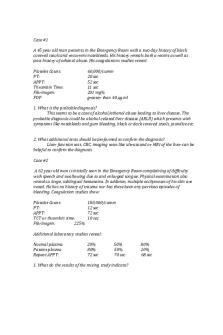Haematology Lecture 3 – Coagulation and Haemostasis PDF

| Title | Haematology Lecture 3 – Coagulation and Haemostasis |
|---|---|
| Course | Haematology and Blood Transfusion Science |
| Institution | University of Essex |
| Pages | 2 |
| File Size | 127.3 KB |
| File Type | |
| Total Downloads | 46 |
| Total Views | 139 |
Summary
Download Haematology Lecture 3 – Coagulation and Haemostasis PDF
Description
Haematology Lecture 3 – Coagulation and Haemostasis
Haemostasis- maintaining fluidity of blood and preventing blood loss. Primary Haemostasis- Interaction between blood vessels, platelets and van Willebrand factor. Forming clot. Secondary Haemostasis- Fibrin strands to strengthen clots Fibrinolysis- Degradation of fibrin clot to prevent vascular occlusion, removing clot when wound is healed. Blood vessel structure and primary haemostasis. Intima endothelial cell layer acts as a barrier, shielding against structures in the basement membrane (microfibrils) which can then interact with blood procoagulants. Primary haemostasis is triggered when microfibrils, which consist mainly of collagen, are exposed.
Platelets usually stay closer to the intima endothelial layer, as they can monitor the integrity of this layer. (whereas RBC’s stay centrally)
Von Willebrand factor. – damage to endothelial cells, release vWF, a large protein, activating platelets. (that interact with collagen)
Platelet structure. Actin filaments, microtubules- help retain disc structures. GPIb- stick to wVF. – binds to collagen GPIIb – GPIIIa- form a complex which binds to fibrinogen a-granule – contains coagulation factors which are rleased when platlets are activated.
PRIMARY HAEMOSTASIS (FORMATION OF BLOOD CLOT MECHANISM) vWF, is a large protein. Binds to collagen after vessel damage, where factor VIII is released, triggering binding of wVF to platelet receptor GPIb Blood flow knocks down plateltes in induce further interactions between GPIb receptros and vWF proteins.
Other platlet GP receptors stabilise adhesion to collagen (like seen in figure above)
Main platelet agonists are Thrombin (Factor IIa) Thromboxane A2 (TXA2)...
Similar Free PDFs

Haemostasis - Lecture notes 7
- 4 Pages

Haematology notes
- 44 Pages

Coagulation drugs
- 6 Pages

Haematology questions mcq
- 12 Pages

Coagulation Case Studies
- 9 Pages

CV Coagulation notes
- 11 Pages
Popular Institutions
- Tinajero National High School - Annex
- Politeknik Caltex Riau
- Yokohama City University
- SGT University
- University of Al-Qadisiyah
- Divine Word College of Vigan
- Techniek College Rotterdam
- Universidade de Santiago
- Universiti Teknologi MARA Cawangan Johor Kampus Pasir Gudang
- Poltekkes Kemenkes Yogyakarta
- Baguio City National High School
- Colegio san marcos
- preparatoria uno
- Centro de Bachillerato Tecnológico Industrial y de Servicios No. 107
- Dalian Maritime University
- Quang Trung Secondary School
- Colegio Tecnológico en Informática
- Corporación Regional de Educación Superior
- Grupo CEDVA
- Dar Al Uloom University
- Centro de Estudios Preuniversitarios de la Universidad Nacional de Ingeniería
- 上智大学
- Aakash International School, Nuna Majara
- San Felipe Neri Catholic School
- Kang Chiao International School - New Taipei City
- Misamis Occidental National High School
- Institución Educativa Escuela Normal Juan Ladrilleros
- Kolehiyo ng Pantukan
- Batanes State College
- Instituto Continental
- Sekolah Menengah Kejuruan Kesehatan Kaltara (Tarakan)
- Colegio de La Inmaculada Concepcion - Cebu









